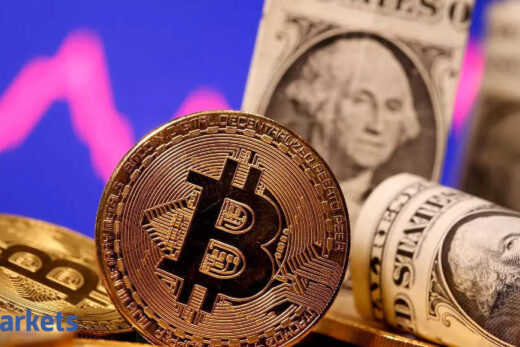Speculators betting for years on bitcoin becoming a stateless digital currency that’s widely used for online retail and payments are largely responsible for its parabolic price rises. But they also seed the sort of blinding volatility that makes that ambition almost untenable.
Bitcoin’s 30 per cent plunge on Tuesday after another Chinese government crackdown is not unique. Daily moves of more than 20 per cent have been frequent during the past 6 years. At almost 4.5 per cent, median daily price swings over that time period are more than 6 times that of the main Transatlantic euro/dollar exchange rate.
And while some online retailers might accept bitcoin as payment for goods priced in dollars, few could manage the potential accounting chaos of sticker pricing in bitcoin if its value can routinely shift by a fifth in just hours.
The flipside is true for buyers. If you think bitcoin’s price keeps on rising over time – much like the latest quadrupling over the past 12 months – then why would you surrender those gains by paying for anything with bitcoin today?
And so if that role as a transaction currency or stable store of value remains elusive, it’s essentially just a game of hoarding a finite number of tokens by small groups of people that routinely involves wild, illiquid swings whenever regulators pounce, backers tweet support or big players cash in.
As ever, arguments about pros and cons of crypto tokens divide among believers and non-believers – blind faith versus instant dismissal, cheer-leading versus scorn.
Deutsche Bank this week likened bitcoin belief structures to the so-called “Tinkerbell effect” – a theory drawing from childrens’ book character Peter Pan’s claim that the fairy only exists because the kids believe she does.
“In other words, the value of Bitcoin is entirely based on wishful thinking,” wrote Deutsche analyst Marion Laboure.
Laboure estimates that less than 30 per cent of transactions in bitcoin are currently related to payments – the rest is trading, speculation, investment or related activities.
And she reckons its liquidity as an investment asset is low. With about 28 million bitcoins changing hands last year, that’s 150 per cent of all those in circulation – almost half the equivalent metric for Apple shares.
TINKERBELL, ARK AND MUSK
With a market capitalisation still about $1 trillion, governments can’t ignore bitcoin, even if central banks continue to dismiss its wider systemic importance. They may even welcome the fact its emergence over the past decade has spurred so-called “fintech” innovation as they gradually develop their own central bank digital currencies over the coming years.
But Deutsche’s Laboure reckons more crackdowns will come – and most likely the whenever bitcoin even looks like rivalling their currencies for payment.
“It is no surprise that governments are not inclined to give up their monetary monopolies. Throughout history, governments first regulate and then take ownership.”
If so, what’s the endgame of all the speculation and hoarding – which just further limits bitcoin supply and drives the price higher? Is it just “pass the parcel” while the music keeps playing? Or are people with money to burn punting for quick gains and trading strategically by timing entry and exits?
Some argue there is genuine demand for crypto transfers within the half trillion dollars per year of global remittances, as migrant workers often need to funnel money back to poorer countries with strict formal exchange controls.
Others claim crypto privacy features draw in demand from criminals, as per this month’s ransomeware hack at Colonial pipeline. But that will just hasten more regulation. Investment arguments beyond simply punting it ever higher range from a lack of “correlation” with other assets to a potential role as an inflation hedge – an odd assertion given its latest reversal comes amid all the post-pandemic inflation scares.
Powerful backers have a outsize say too, but are increasingly erratic.
Tesla billionaire Elon Musk drove the price skywards earlier this year by saying Tesla would accept bitcoins as payment for its dollar-priced electric vehicle and add bitcoin to the company balance sheet – only to backtrack last week by warning about excessive energy usage in bitcoin mining.
With no obvious rationale, star tech stock investor Cathie Wood of Ark Invest claimed this week that bitcoin would rise another tenfold again after it registered a 50 per cent loss in a month.
At the $500,000 level she posits, the market cap of bitcoin would then be $10 trillion – or a third of the entire M1 money supply of G20 economies.
London School of Economics’ Jon Danielsson reckons that as a result of the concentration of bitcoin ownership, that sort of move would create new multi billionaires – or even the first trillionaire. And that would wildly exaggerate existing wealth skews as the gap between bitcoin haves and have-nots soars to intolerable levels, making a mockery of claims of crypto “democratisation”.
As a result, he thinks co-existence of bitcoin and so-called fiat currencies is impossible. It’s all or nothing.
If it replaces all G20 currencies in circulation, that would then see each bitcoin priced at $1.5 million.
Reality or fiction?
“Bitcoin is a bubble,” Danielsson concludes. “It makes sense to ride the bubble as long as possible – just get out in time.”
(By Mike Dolan, Twitter: @reutersMikeD)



